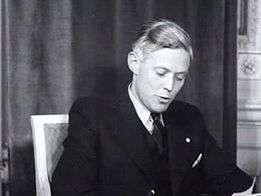John Snagge
| John Snagge | |
|---|---|
 Reading the news c1944 | |
| Born |
John Derrick Mordaunt Snagge 8 May 1904 Chelsea, London, England |
| Died |
26 March 1996 (aged 91) Slough, Berkshire, England |
| Occupation | Commentator and presenter |
| Known for | Sport commentary |
| Spouse(s) |
Eileen Joscelyne (1936-1980; her death) Joan Wilson (1982-1992;her death) |

John Derrick Mordaunt Snagge OBE (8 May 1904 – 26 March 1996) was a long-time British newsreader and commentator on BBC Radio.
Life
Born in Chelsea, London, he was educated at Winchester College and Pembroke College, Oxford, where he obtained a degree in law. He then joined the BBC, taking up the position of assistant director at Stoke-on-Trent's new local radio station. He broadcast his first sports commentary (of a Hull City versus Stoke City football match) in January 1927, after the BBC obtained the rights to cover major sporting events.
In 1928, Snagge was transferred to London to work as one of the BBC's main announcers alongside Stuart Hibberd. From 1931 until 1980, he commentated on the annual Oxford-Cambridge Boat Race. He provided commentary for the coronation of King George VI in 1937 and again in 1953 for the coronation of Queen Elizabeth II.
At the start of the Second World War, Snagge was made the BBC's presentation director and delivered important radio announcements as the war unfolded. By the time of the D-Day landings in 1944, he was presenting the magazine programme War Report which featured regular news from the beaches of Normandy.
In the early 1950s, Snagge played a role in negotiations that led to the radio comedy series The Goon Show being commissioned by the BBC. He was also the subject of many running gags during the show, and provided many self-parodying announcements, usually recorded. He also featured as himself in the episode The Greenslade Story, alongside regular announcer Wallace Greenslade. He was a defender of the show against many efforts to cancel it, even to staking his career on it. Later, in the 1970s, he echoed his wartime role by appearing as the newsreader in the radio version of Dad's Army, setting the scene at the beginning of every episode.
On 5 July 1954, John Snagge read the first BBC television news bulletin.
He appeared as himself in the 1960 TV Hancock's Half Hour episode, 'The East Cheam Centenary', where he commentates on the street 'procession', from Hancock's bedroom at 23 Railway Cuttings.
Snagge retired in 1965, but continued to provide commentaries for the Boat Race until 1980. The same year his wife Eileen died. Around this time he also appeared on Noel Edmonds' Radio 1 show on Sunday mornings, a role subsequently taken up by Brian Perkins.
During the 1949 University Boat Race Snagge's voice filled with excitement and he reported: "I can't see who's in the lead but it's either Oxford or Cambridge".
He was the guardian of Wally Hope, founder of the Stonehenge Free Festival, until his premature death in 1975.
John Snagge died in Slough from throat cancer in 1996, aged 91.
Family
Snagge was the son of Sir Thomas Mordaunt Snagge (1868–1955)—Judge Mordaunt Snagge, knighted in 1931,[1] and Gwendaline Rose Emily Colomb (1876–1966).
His paternal grandfather was Sir Thomas William Snagge, KCMG (1837–1914).[2] His mother's father was the British naval strategist, Sir John Colomb, KCMG (1838–1909).
He was married twice: firstly, in 1936, to Eileen Mary Joscelyne (the daughter of Harry Percy Joscelyne).[3] She died in 1980. He married, secondly, Joan Wilson in 1982. She predeceased him in 1992.[4]
References
- ↑ The National Archives of the United Kingdom, Census Returns of England and Wales, 1911 (reference RG14; piece 405).
- ↑ Author: Thomas William Snagge, accessed on 6 December 2013. Debrett's House of Commons, and the Judicial Bench, 1922, p. 367.
- ↑ The Times (Monday, 21 September 1936), p. 15. Marriage registered in Eton Registration District in the third quarter of 1936
- ↑ The Independent: "Obituary: John Snagge", 28 MARCH 1996
Sources
External links
- John Snagge at the Internet Movie Database
- John Snagge at the Wayback Machine (archived 27 September 2007) at the Radio Academy's Hall of Fame.
- John Snagge announcing the D Day landings, 6 June 1944